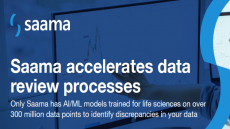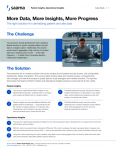Use of RWE, AI elevating drug development: Sidley

The COVID-19 pandemic has served as a catalyst for increased adoption of a number of useful trial tools and technologies. One example is real-world evidence (RWE), which the drug development field has grown to embrace since the virus began causing study interruptions and other obstacles—and to unlock the usefulness of RWE, professionals have been turning to artificial intelligence (AI).
To learn more about AI and RWE, expected regulatory shifts, how to minimize liability, and more, Outsourcing-Pharma connected with a slate of experts from life-science-centered law firm Sidley:
- Francesca Blythe, healthcare; privacy and cybersecurity
- Zina Chatzidimitriadou, food, drug, and medical device regulatory; IP litigation
- Jaclyn Fonteyne, food, drug, and medical device regulatory
- Michelle Ramirez, products liability; litigation
- Josefine Sommer, environmental; food, drug, and medical device compliance and enforcement; food, drug, and medical device regulatory
- Eva von Mühlenen, food, drug, and medical device compliance and enforcement; food, drug, and medical device regulatory; healthcare
- Becky Wood, food, drug, and medical device regulatory; life sciences
OSP: Could you please share some perspective on how the use and understanding of RWE in the pharma/drug development field have evolved in recent years?
BW, JF: Since the passage of the 21st Century Cures Act in 2016, the FDA has increased its focus on the use of real-world data (RWD) as real-world evidence (RWE) in regulatory decision-making, including determining the approval of products and new indications, supporting clinical trial designs, and enhancing pharmacovigilance. The FDA has published several guidance documents and policies since the 21st Century Cures Act addressing the potential of computers, mobile devices, wearables, and other innovative technology to gather, store, and analyze data to assist in regulatory decisions, including FDA, Real-World Evidence and has begun to rely explicitly on RWE in drug approvals.
Robert Califf’s return to FDA as commissioner renewed focus on these issues. In his remarks following his confirmation, Dr. Califf emphasized “the fundamental need to enhance our ability to collect and analyze data to ensure we have the necessary and best evidence to make well-informed decisions across the expanse of our areas of responsibility.”
EVM, JS, ZC: In the European Union (EU), RWD and RWE have been used in the development, support of authorizations, and monitoring of medicines. In 2017, the European Medicines Agency (EMA) and Heads of Medicines Agencies (HMA) set up a joint Big Data Task Force (Task Force).
In January 2020, the Task Force proposed 10 priority recommendations, including the establishment of an EU RWE platform to access and analyze healthcare data from across the EU (Data Analysis and Real World Interrogation Network, or DARWIN). The joint Big Data Steering Group supersedes the Task Force and advises the EMA Management Board and HMA on prioritization and planning of actions to implement the priority recommendations.
The DARWIN EU project is providing an IT infrastructure that aims at generating, providing, and integrating reliable evidence on the use, safety, and effectiveness of medicines for human use from real-world healthcare databases (a federated network of data) across the EU. Erasmus University Medical Centre Rotterdam was selected to establish and maintain the DARWIN EU Coordination Centre and support its work to prepare individual data use agreements with data partners. The Coordination Centre will be overseen by the EMA. The EMA expects DARWIN to be fully operational in 2024.
The recent proposal for a regulation to set up a European Health Data Space (EHDS) proposal for a Regulation provides for greater access to health data, including RWD, by medicines developers and EU policymakers alike. According to the EMA, DARWIN will act as a pathfinder for the EHDS and will ultimately connect to the EHDS services, enabling the use of the EHDS in the context of medicines regulation in Europe.
The Big Data Steering Group expects four RWE studies to be initiated with 10 data partners through DARWIN by the fourth quarter of this year, with the number of EU studies increasing to more than 100 each year by the beginning of 2025. In addition, the Medicines and Healthcare products Regulatory Agency (MHRA) in the UK has issued a guidance on the use of RWE in clinical studies to support regulatory decisions and the first more specific guideline in the series on randomized controlled trials using RWD to support regulatory decisions.
It is interesting to note that the U.K.’s National Institute for Health and Care Excellence (NICE) recently published its real-world evidence framework, which sets out sources, use cases, and the value and applicability of RWE for reimbursement decisions of new technologies. The framework identifies when RWD can be used to resolve gaps in knowledge and describes best practices for planning, conducting, and reporting RWE studies to improve the quality and transparency of evidence.
Marketing authorization agencies globally recognize the growing importance of RWE to support medicinal product authorization applications. However, the quality and interpretation of RWD for deriving RWE still pose considerable challenges that need to be addressed at the scientific, regulatory, and legal levels.
MR: With the increased adoption of RWD and RWE noted above, there has also been a trend toward a general increased public expectation for openness and transparency with respect to drug safety and new safety signals. There is also increased public awareness and understanding of drug safety, including a “risk-benefit analysis,” as a result of the pandemic, which cuts both ways for life sciences companies.
There have been a number of articles considering whether this increased awareness may positively impact jury attitudes toward the pharmaceutical industry (some refer to it as a “halo effect”). Whether the halo effect continues remains to be seen, but the public’s general understanding and awareness of signal detection and management, as well as desire for transparent communication, will likely continue beyond the pandemic.
OSP: How did the industry’s employment of and reliance on RWE change since the start of the pandemic?
BW, JF: The COVID-19 pandemic increased interest in deploying RWD and RWE in product development and regulatory decision-making, as the agency and industry aimed to respond with alacrity to the evolving public health environment. FDA recognized that RWD and RWE may allow clinicians and the Agency to better understand and use COVID-19 medical countermeasures, including vaccines, drugs, and diagnostics, and also acknowledged that “RWE sometimes informed pandemic responses.”
FDA partnered with a third-party vendor to “develop a system of studies for the rapid assessment of the safety and effectiveness of COVID-19 inpatient [medical countermeasures (MCMs)].”
RWD/RWE can also be a valuable tool in pharmacovigilance for COVID-19 vaccines, therapeutics, and diagnostic tests, and presents an opportunity for the industry to work closely with regulators. Some companies have embraced “hyper-pharmacovigilance,” announcing that they are using multiple data sources to monitor and identify safety signals. Going forward, this 360 focus on data collection and mining to assess potential safety signals in the context of COVID response is likely to become increasingly common outside of COVID response.
EVM, JS, FB, ZC: During the COVID-19 pandemic, RWE rapidly provided impactful evidence on the safety of drugs and vaccines. The European Commission (EC) launched the EHDS and proposed a draft regulation on the EHDS in May 2022.
The EC stated that the COVID-19 pandemic “has clearly demonstrated the importance of digital services in the health domain” and it was evident that the European Centre for Disease Prevention and Control and the EMA “struggled to obtain rapid access to data and evidence for decisions and scientific guidance on the response to the pandemic”.
The COVID-19 pandemic has emphasized the importance of RWE in relation to monitoring the effectiveness and safety of vaccines. To that end, EMA stated that real-world monitoring “complements regular safety-monitoring activities, including spontaneous reporting of suspected side effects by patients and healthcare professionals."
In July 2022, EMA endorsed a joint statement calling for international collaboration to enable the generation and use of real-world evidence for regulatory decision-making published by the International Coalition of Medicines Regulatory Authorities (ICMRA). Furthermore, researchers and regulators agreed to establish and reinforce collaboration allowing efficient sharing of data and experience in relation to RWE beyond the COVID-19 pandemic.
During the pandemic, for drugs relevant to the pandemic, the agencies deviated from the usual approval process. In order to overcome delays in the strict process of -> submission, -> review and -> approval - there was exceptionally a dynamic and iterative exchange allowed. New data could be submitted almost in real time and thus the approval could be accelerated significantly.
OSP: Can you share some of the considerations that must be weighed when looking to use AI data for RWE in drug discovery efforts?
BW, JF: After the 21st Century Cures Act in 2016, the FDA published a framework for its use of RWE that focused on RWD being reliable and relevant to regulatory decision-making.
Recently, FDA has explained parameters for the use of electronic health records (EHR) and emphasized the importance of standardized processes for the selection, validation, and curation of RWD from electronic health care data to support regulatory decision, and methods for developing RWE from that data. The FDA also issued guidance related to RWD from registries, data standards for product submissions, and RWD used in clinical investigations.
FDA also has focused on mitigating cybersecurity risks surrounding the collection of data using innovative technologies.
FB: There are a number of challenges from a GDPR perspective as it relates to the use of AI data for RWE – in particular, around the lawful collection of such data, the security of the data, and the ability to use this data for regulatory filings. Some examples of challenges faced include the following:
- where AI systems process personal data to infer data about individuals, the AI must be sufficiently statistically accurate and avoid discrimination. Consideration must also be given to the reasonable expectations of the data subjects. Concerns have been raised in this regard about algorithmic fairness and bias by the European Data Protection Board and the European Data Protection Supervisors in their Joint Opinion 5/2021 on the draft AI Act;
- individuals must be provided with a meaningful explanation as to the logic behind the processing carried out by the AI system, the reasoning that lead to specific automated decisions concerning them, as well as the possible consequences of the processing. However, the use of AI systems that rely on technical and difficult-to-understand algorithms will make it more challenging to be clear, open, and honest with individuals about how their personal data is processed in line with transparency obligations;
- compliance with the purpose limitation principle i.e., whether individuals have been adequately informed about the purposes for which their personal data will be used and then ensuring the data are only used for these purposes;
- compliance with the data minimization principle is inherently problematic when using AI because AI systems and algorithms, by their nature, perform more accurately and are improved, the more personal data is inputted into the AI system; and
- the implementation of appropriate security measures to prevent personal data (which is often very sensitive) from being accidentally or deliberately compromised and to ensure the ongoing integrity of the data.
EVM, JS, ZC: In November 2021 the EMA published its vision for use of RWE in EU medicines regulation. The two underlying articles authored by the EMA set out targets to ensure that by 2025 the use of RWE will have been enabled and established across the spectrum of regulatory use cases, so relevant guidelines might be forthcoming (although no reference to AI is made).
Although the EHDS Regulation is still in draft form, it will have the effect of enabling the collection of data, including RWD, from AI systems or devices involving AI. Until now, the situation has been that when European data scientists conducted research, data collection involved attempting to source data from different hospitals and different systems. The bulk of European research has, therefore, so far focused on cleaning data and reducing its noise in order to generate data that is actionable and capable of generating insights.
The EHDS proposal regulation is a step towards rectifying this situation for Europe. It is expected that more tailored guidance will follow in the future to explain how RWD collected and analyzed through AI technologies can be applied in drug discovery and development efforts and approaches to new preventative and treatment methods.
The Joint HMA/EMA Workshop on AI in medicines regulation that took place in April 2021 produced a report presenting, among others, applications of AI in medicines and medicines regulation and digitalization activities at EMA, as well as examples of the use of AI across the lifecycle of medicinal products where RWD is used to understanding which populations benefit the most from the medicines. The workshop concluded with a list of compiled recommendations that may be used in future legislative and regulatory initiatives.
At the WHO level, there is a global report on AI in health and six guiding principles for its design and use that developers would be advised to take into account.
OSP: How can life sciences companies maximize their use of RWE while minimizing liability/risk?
BW, JF: Life sciences companies should keep current on FDA’s quickly evolving policies and precedents. These changes may help to speed the development of new therapies and diagnostics, and the identification of potential safety signals for marketed products.
At the same time, these advances may increasingly create heightened expectations that regulated entities undertake enhanced efforts to utilize these tools. For example, if new methods of data analysis make hyper-vigilance possible with respect to pharmacovigilance in some cases, such as COVID response, regulators and private parties could begin to urge that same level of scrutiny across other settings.
EVM, JS, FB, ZC: As per the above, there are a number of challenges from a GDPR perspective as it relates to the use of RWE. Given the potential fines under the GDPR for non-compliance (i.e., the greater of 4% of annual worldwide turnover or EUR 20 million) life sciences companies should ensure that steps have been taken to meet their GDPR obligations and in particular, their accountability obligations.
In addition, there is a lack of consistency in the requirements and decisions of the FDA and the EMA in relation to the use of RWE and RWD, which represents one of the obstacles for life science companies. In a survey conducted by the European Federation of Pharmaceutical Industries and Associations (EFPIA), one respondent pointed out that it expected “challenges in terms of availability of relevant expertise by regulators in relation to scientific advice, marketing authorization assessments as well as inspections”.
Furthermore, there were “important limitations to consider, such as selection bias and variations in timepoints for data collection, and the quality of the data used”.
MR: As per the above, life sciences companies should continue to comply with FDA policies and any other regulatory obligations in order to minimize litigation risk and liability. While principles of litigation risk management remain the same – proactively collect data and analyze it in real time – there is an increased expectation for companies to adopt and use new technology as it becomes available. The standard of care a company is held to in U.S. litigation will generally be compared to its peers, which may include the use of certain data management tools and technology.
OSP: Can you share some insight as to how regulatory changes have impacted the use of AI and RWE?
BW, JF: The 21st Century Cures Act stood up a Real-World Evidence program at FDA. In 2019, FDA described the development of the Agency’s RWE program as a “top strategic priority for the FDA.” As mentioned above, since the 21st Century Cures Act was enacted in 2016, FDA has published a framework and several guidances on the topic. The FDA continues to focus on RWE in the context of the pandemic and to support non-pandemic-related medical product development and approval.
The FDA also is evaluating and considering AI in various contexts. For example, the FDA has published guidance on the use of digital health technologies in drug development and clinical investigations. The FDA urged sponsors to pay attention to cybersecurity risks that could impact the performance of digital health technology used to collect data, as it could compromise patient privacy.
FB: See below for an overview of the regulatory changes which will potentially impact use of AI and RWE. It is important, however, to note that whilst the EU’s AI Act is still in draft form and companies may be tempted to adopt a wait-and-see approach, there are a large number of existing guidance documents published by European Data Protection Authorities (DPAs) and other regulators relating to the use of AI – which may require companies to take action now.
The UK’s Information Commissioner’s Office has in particular, been very active in this area with the publication of various guidance documents including an AI and Data Protection Risk Toolkit, which serves as a form of AI audit document. These guidance documents (whilst industry neutral) should be considered by life sciences companies when leveraging AI in the context of RWE.
Consideration should also be given to the increased focus by DPAs on cross-border data flows which are inevitably increased through the use of digital health tools (such as AI). In particular, the impact this has on transparency for individuals, information security, and the potential for loss of control of the data should all be worked through.
OSP: What changes to regulations might still be on the horizon, and what advice might you have to offer drug development stakeholders looking to ready themselves for what lies ahead?
BW, JF: FDA has signaled renewed attention to further developing the infrastructure around RWE, with Commissioner Califf highlighting a priority of “modernizing FDA’s digital infrastructure” to enable “swift, systematic gathering of patient data, collectively yielding a detailed understanding of ‘real-world’ benefits and risks of medical products.”
COVID has already pointed the way to enhanced flexibility with respect to using RWD in product development and pharmacovigilance. Regulated entities should look for opportunities to be thought partners with the agency and to share their ideas for additional reliable and relevant uses of RWD in regulatory decision-making.
EVM, JS, FB, ZC: In 2020, the European Commission published a communication on Shaping Europe’s Digital Future. This Communication sets out the vision and values underlining new regulations on digital services and data usage, including, for example:
- the AI Act – draft published by the European Commission in April 2021. The Act is intended to regulate the use, placing on the market, and putting into service certain AI systems (which are defined very broadly) in the EU. The premise behind the AI Act is to address existing fragmentation in the regulation of AI in the EU as well as to address concerns around potential risks posed by unregulated uses of AI. In terms of application of the AI Act, it is industry neutral and has extra-territorial application. The AI Act follows a risk-based approach and regulates AI systems in accordance with the level of risk they present i.e., unacceptable (which are banned), limited (subject to certain transparency requirements), minimal (not regulated under the Act), and high risk (including, all devices regulated under the EU Medical Devices Regulation and for which the majority of obligations apply); and
- the European Health Data Space Regulation – draft published by the European Commission on May 2022. The draft Regulation seeks to (amongst other things) facilitate the trustworthy and secure sharing of electronic health data for secondary research purposes. The draft Regulation has been welcomed by industry as an ambitious attempt to remove the barriers to health data for scientific research. However, a large number of legal and policy issues still need to be addressed (including, its scope and how it aligns with existing and proposed data laws) to ensure industry can comply with the requirements of the Regulation and that the Regulation achieves its stated objectives.
The Big Data Steering Group designed a new workplan for 2022-2025 that aims at using the evidence generated from Big Data to accelerate medicines development, improve treatment outcomes and facilitate earlier patient access to new treatments. As mentioned above, the DARWIN program which will enable access and analysis of RWE is expected to conduct more than 100 studies per year by 2025. Furthermore, the publication of a good practice guide on real-world metadata, followed by a public catalog of European RWD, is on the list of deliverables.
The work of the new EMA Methodologies Working Party includes development of guidance in relation to RWE. Expert advice will be strengthened through European Specialized Expert Communities initially in AI and RWE. In addition, reports on pilot studies on the use of RWE by EMA scientific committees will be published incrementally and concluded in 2025 with a report on RWE in regulatory decision-making.
In January 2022, EFPIA published the Evidence MIX Report that identifies priority areas for legislative change as part of the Commission’s review of the EU’s general legislation on medicines for human use. One of the primary topics is the use of RWD and RWE. In the report, it is stated that regulators progressively accept the use of RWD and RWE to support regulatory decisions. RWD and RWE have been traditionally used for pharmacovigilance in post-authorization phase and within the oncology field in pre-authorization phase. However, there is growing interest in their potential, especially in light of regulators’ efforts to support the introduction of new technologies.
There is typically still a considerable delay in regulatory review and approval of post-marketing changes. It is to be expected, that there will be the need to transform the model for the regulatory approval process - so for submission, review, and especially the exchange of data between company sponsors and regulators in the approval of medicinal products.
An approach toward an agile, platform-based, and in particular iterative exchange will enable companies to release real-time updates simultaneously to multiple regulators. This model will also facilitate the incorporation of data from non-traditional sources such as real-world data. In order to enable the exchange, companies should closely follow the developments regarding standards on relevant data formats and requirements for interoperability.
In regards to anticipating regulatory changes, companies are furthermore well advised to monitor developments regarding health technology assessment regulations. AI-based models will in particular enable to include health technology assessment (HTA) considerations in the target product profiling (TPP) considerations. Just meeting regulatory endpoints in clinical research will not suffice in the future, rather planning and generating “targeted” HTA data from the outset will be key in the marketing access process.
OSP: How can companies like Sidley help drug development professionals at various points on the pipeline with these challenges?
BW, JF: Our team frequently works with clients who are assessing the use of RWD as RWE in product development and pharmacovigilance. Our team is also skilled in engaging directly with FDA on a variety of issues that may face industry as they consider the use of AI and RWD/RWE in regulated activities.
EVM, JS, FB, ZC: We counsel a large number of life sciences companies on a wide range of data protection, privacy, information security and data commercialization matters, including advising on how best to ensure their use of AI (and other digital health technologies) in the context of RWE complies with the rapidly evolving legal standards for privacy, cybersecurity and data in the EU/UK. The law in this area is complex and evolving quickly, so our ability to deploy experienced and talented lawyers with substantial experience in these matters offers great practical benefits to our clients.
With our global expertise and many former health agency experts, Sidley has unparalleled insights and knowledge regarding this highly regulated and interwoven regulatory framework which allows us to remain on top of the constant regulatory updates and help the client navigate the complexities.
MR: In addition to defending litigation actions, our team counsels clients on ways to mitigate litigation risk at every stage of drug development – including prior to FDA approval and prior to litigation. We do so by providing pre-litigation counseling and conducting risk assessments with the goal of providing the tools to mitigate challenges before they ever turn into litigation.

























